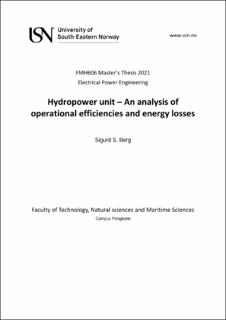| dc.description.abstract | The beginning of the “green shift” has already started in the Nordic power grid. In this context, it means extensive use of intermittent energy sources like wind and solar power. The intermittent sources impact the operational regime of conventional hydropower units (HPU) into unfavourable situations, resulting in reduced operational efficiency and increased energy losses or revenue.
One of Norway’s largest power producers, Skagerak Kraft, has started a research program collaborated with the University of South-Eastern Norway (USN) to investigate the upcoming challenges related to HPUs and the “green shift”. This thesis will be the beginning of this research program with the purpose of analysing Åbjøra and Sundsbarm HPU concerning operational efficiency and investigate the efficiency under extended operational regimes.
For the analyse, it has been made a static model in MATLAB that estimates and maps the efficiencies and energy losses of the HPUs. The model determines the operational efficiency based on the operational data from the generators. The data was provided by Skagerak Kraft and contained information from the period 2020 with measurements of active power, reactive power and voltage.
The results identified the best efficiency point (BEP) of 92.25 % and 92.14 % in Åbjøra and Sundsbarm, respectfully, with an estimated weighted average efficiency (WAE) of 91.6 % for Åbjøra and 91.9 % for Sundsbarm. The analysis has shown a solid correlation between reduced operational efficiency and frequent use of frequency restoration reserve (FRR), also known as grid balancing. The magnitude of the active power has shown to be the dominating factor related to efficiency, where operations at low active power attain the lowest efficiencies. However, changes in reactive power could be assumed to have only a minor effect on efficiency. | |
